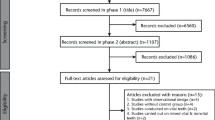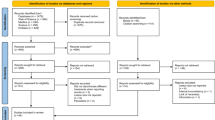Abstract
Objectives
The aim of this study was to analyze the strength of risk factors related to endodontic flare-ups and rank them in order of their importance
Materials and methods
A systematic literature search of PubMed, Cochrane Central Register of Controlled Trials, Scopus, and ISI Web of Knowledge, and grey literature was conducted up to November 2019. One hundred ninety-eight publications were identified. Twelve records fulfilled the eligibility criteria, and eight significant risk factors for flare-up, namely, “Periapical lesion,” “multiple-visit treatment,” “preoperative pain,” “necrotic teeth,” “female gender,” “retreatment,” “percussion pain,” and “analgesics,” were selected to construct the simulation model. The final data pool was established by the integration of data of common risk factors in the included articles. Monte Carlo method was used to analyze of combined numerical data, for simulation of the risk factor impacts. Ten thousand iterations were generated in the simulation model.
Results
The results of the simulation revealed that the risk estimates of the factors had varying ranges of influence and probability on the flare-up risk. “Periapical lesion” was found to be the most sensitive risk factor, following by “preoperative pain” which was ranked the second place. The third-ranked risk factor was “multiple-visit treatment.” The least sensitive risk factors for endodontic flare-up were “retreatment,” “female gender,” “necrotic teeth,” and “analgesics.”
Conclusions
The present study provides better comprehension on the importance of risk factors for flare-up based on their risk estimates.
Clinical relevance
A Monte Carlo simulation was adopted to identify the most influential risk factors for endodontic flare-up with a ranking, which can be used to provide meaningful predictions and further insights into clinicians’ perception of flare-up risk.




Similar content being viewed by others
References
Pak JG, White SN (2011) Pain prevalence and severity before, during, and after root canal treatment: a systematic review. J Endod 37:429–438
Pasqualini D, Mollo L, Scotti N, Cantatore G, Castellucci A, Migliaretti G, Berutti E (2012) Postoperative pain after manual and mechanical glide path: a randomized clinical trial. J Endod 38:32–36
Azim A, Azim K, Abbott P (2017) Prevalence of inter-appointment endodontic flare-ups and host-related factors. Clin Oral Investig 21:889–894
Morse DR, Koren LZ, Esposito JV et al (1986) Asymptomatic teeth with necrotic pulps and associated periapical radiolucencies: relationship of flare-ups to endodontic instrumentation, antibiotic usage and stress in three separated practices at three different time periods: part 1:1963–1970. Int J Psychosom 33:5–17
Iqbal M, Kurtz E, Kohli M (2009) Incidence and factors related to flare-ups in a graduate endodontic programme. Int Endod J 42:99–104
Walton RE (2002) Interappointment flare-ups: incidence, related factors, prevention, and management. Endod Top 3:67–76
Onay EO, Ungor M, Yazici AC (2015) The evaluation of endodontic flare-ups and their relationship to various risk factors. BMC Oral Health 15:142
Alves VO (2010) Endodontic flare-ups: a prospective study. Oral Surg Oral Med Oral Pathol Oral Radiol Endod 110:e68–e72
Imura N, Zuolo M (1995) Factors associated with endodontic flare-ups: a prospective study. Int Endod J 28:261–265
Tanalp J, Sunay H, Bayirli G (2013) Cross-sectional evaluation of post-operative pain and flare-ups in endodontic treatments using a type of rotary instruments. Acta Odontol Scand 71:733–739
Oginni A, Udoye C (2004) Endodontic flare-ups: comparison of incidence between single and multiple visit procedures in patients attending a Nigerian teaching hospital. BMC Oral Health 4:4
Yoldas O, Topuz A, Isçi A et al (2004) Postoperative pain after endodontic retreatment: single- versus two-visit treatment. Oral Surg Oral Med Oral Pathol Oral Radiol Endod 98:483–487
Torabinejad M, Kettering J, McGraw J et al (1988) Factors associated with endodontic interappointment emergencies of teeth with necrotic pulps. J Endod 14:261–266
Nair M, Rahul J, Devadathan A, Mathew J (2017) Incidence of endodontic flare-ups and its related factors: a retrospective study. J Int Soc Prev Community Dent 7:175–179
Cheng Y, Cheung G, Bian Z et al (2006) Incidence and factors associated with endodontic inter-appointment emergency in a dental teaching hospital in China. J Dent 3:516–521
Walton R, Fouad A (1992) Endodontic interappointment flare-ups: a prospective study of incidence and related factors. J Endod 18:172–177
Chen YF, Lin YH, Chen CC et al (2007) Endodontic flare-ups and associated factors in a Taiwanese hospital. J Dent Sci 2:39–44
Pamboo J, Hans M, Kumaraswamy B et al (2014) Incidence and factors associated with flare-ups in a post graduate programme in the Indian population. J Clin Exp Dent e514-519.
Wells GA, Shea B, O’Connell D et al The Newcastle-Ottawa Scale (NOS) for assessing the quality of nonrandomised studies in meta-analyses. The Ottawa Hospital Research Institute. http://www.ohri.ca/programs/clinical_epidemiology/oxford.asp Accessed 12 February 2020.
Uusitalo L, Lehikoinen A, Helle I, Myrberg K (2015) An overview of methods to evaluate uncertainty of deterministic models in decision support. Environ Model Softw 63:24–31
Farrance I, Frenkel R (2014) Uncertainty in measurement: a review of Monte Carlo simulation using Microsoft excel for the calculation of uncertainties through functional relationships, including uncertainties in empirically derived constants. Clin Biochem Rev 35:37–61
Buhara O, Pehlivan S (2019) Monte Carlo simulation of reasons for early failure of implants: effects of two risk factors. Br J Oral Maxillofac Surg 57:12–20
Mor C, Rotstein I, Friedman S (1992) Incidence of interappointment emergency associated with endodontic therapy. J Endod 18:509–511
Sim CK (1997) Endodontic interappointment emergencies in a Singapore private practice setting: a retrospective study of incidence and cause-related factors. Singap Dent J 22:22–27
Wong M, Shelley JJ, Bodey T et al (1992) Delayed root canal therapy: an analysis of treatment over time. J Endod 18:387–390
Vose D (2008) Risk analysis: a quantitative guide, ed 3. John Wiley & Sons, Chichester
Buhara O, Pehlivan S (2018) Estimating the importance of significant risk factors for early dental implant failure: a Monte Carlo simulation. Int J Oral Maxillofac Implants 33:161–168
Hamby DM (1994) A review of techniques for parameter sensitivity analysis of environmental models. Environ Monit Assess 32:135–154
Carsey TM, Harden JJ (eds) (2014) Introduction. In: Monte Carlo Simulation and Resampling Methods for Social Science. SAGE, Los Angeles, p 3
Figdor D (2002) Apical periodontitis: a very prevalent problem. Oral Surg Oral Med Oral Pathol Oral Radiol Endod 94:651–652
Siqueira J (2003) Microbial causes of endodontic flare-ups. Int Endod J 36:453–463
Caplan DJ, Chasen JB, Krall EA, Cai J, Kang S, Garcia RI, Offenbacher S, Beck JD (2006) Lesions of endodontic origin and risk of coronary heart disease. J Dent Res 85:996–1000
Jiménez-Pinzón A, Segura-Egea JJ, Poyato M et al (2004) Prevalence of apical periodontitis and frequency of rootfilled teeth in an adult Spanish population. Int Endod J 37:167–173
Siqueira JF, Roças IN, Favieri A et al (2004) Incidence of post operative pain after intracanal procedures based on an antimicrobial strategy. J Endod 28:457–460
Villanueva d P, Chavez LE (2002) Fusobacterium nucleatum in endodontic flare-ups. Oral Surg Oral Med Oral Pathol Oral Radiol Endod 93:179–183
Author information
Authors and Affiliations
Contributions
All authors contributed to the study conception and design. Material preparation, data collection, and analysis were performed by Umut Aksoy, Oğuz Buhara, and Salahi Pehlivan. The first draft of the manuscript was written by Umut Aksoy and Oğuz Buhara, and all authors commented on previous versions of the manuscript. All authors read and approved the final manuscript.
Corresponding author
Ethics declarations
Conflict of interest
The authors declare that they have no conflict(s) of interest.
Ethical approval
This article does not contain any studies with human participants or animals performed by any of the authors.
Informed consent
For this type of study, formal consent is not required.
Additional information
Publisher’s note
Springer Nature remains neutral with regard to jurisdictional claims in published maps and institutional affiliations.
Rights and permissions
About this article
Cite this article
Aksoy, U., Pehlivan, S. & Buhara, O. The top risk factors for endodontic flare-up: a Monte Carlo simulation. Clin Oral Invest 25, 3681–3690 (2021). https://doi.org/10.1007/s00784-020-03692-9
Received:
Accepted:
Published:
Issue Date:
DOI: https://doi.org/10.1007/s00784-020-03692-9




